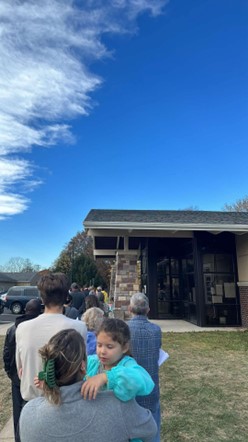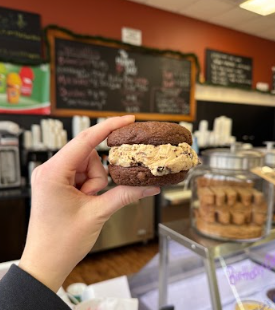Artificial Christmas trees provide greater benefits overall when compared to real Christmas trees. Every year, during the holiday season, a big debate occurs between those who prefer real Christmas trees in their home versus those who prefer artificial ones. While some families have stayed consistent over the years in their Christmas tree choice, others have disrupted their tradition and made a switch.
Many in favor of real trees emphasize their environmental benefits. According to the National Christmas Tree Association, they absorb carbon dioxide, protect the water supply, and are biodegradable. They also mention that one acre of Christmas trees can provide oxygen for up to 18 people every day. However, although real trees are said to be more environmentally friendly, it is important to take into consideration the context of these statistics. Although an acre of Christmas trees contributes greatly to the oxygen supply, that can only happen if they are still in the ground. Experts from the Christmas tree sales department of Walmart mention that the cutting down of 30 Million real trees occurs every year. This contributes to greenhouse gas emissions and the release of methane into the air, a potent greenhouse gas that is harmful to both humans and the environment. Evergreen trees, when still planted in the ground, can provide great benefits; however, when used for the purpose of Christmas, they can no longer be used for this purpose.
Another argument stems from the trees’ recyclability. Many with real trees find success in recycling their trees, as stated by experts from King of Christmas, who say they can be used to grind free mulch if you own a mulch chipper, for arts and crafts with the pine needles, and as a frame for garden plants if stripped down. When it comes to recycling her tree every year, Patricia Croyle, an advocate for real Christmas trees, says, “Yes, I put it in my backyard for birds and other animals to use as shelter in the winter months.” With the variety of fun and positive uses for old Christmas trees also come many conditions. They can only be used for arts and crafts if someone in the family is artsy, can only be used to make mulch if the family owns a woodchipper, and can only be substantial in a garden if a family has the time, money, and space to grow a garden. Even though these are great ways to use an old tree, it depends greatly on the family and their possessions and interests, which makes the recycling benefits conditional. Artificial trees have one main unconditional benefit that outweighs the possibilities that come from recycling a real tree: the ability to reuse them. Each holiday season, bringing out the same tree that was tucked away for the majority of the year saves the environment as well as so much time and money.
Tradition and convenience are two more things that hold a lot of weight in making the final decision between buying an artificial tree or cutting down a real one. Considering quality time with family is the number one reason for going to a Christmas tree farm to chop down your own tree, according to Successful Homemaking, many are inclined to stick with this tradition. Croyle also speaks on the topic of tradition when saying, “It is something my grandparents always did, so it’s just keeping tradition.” For specific families, this is something that can be hard to let go of and is also just a fun event, which is why the tradition still exists today. Real Christmas trees are also said to be more convenient. They do not take up space in the house when it is not Christmas time, and they do not require the bending and altering of plastic branches to make the tree appear presentable. Artificial trees, however, are much more convenient and cost-efficient, making them more appealing to the average household. With the average cost of buying a real tree annually being so high, a fake tree makes it possible to save up to $780 in ten years according to Walmart sales experts. They also create less of a mess, as they do not have loose pine needles, they do not take a long time to set up, and they are guaranteed to have the perfect shape and color you wanted when you first bought the tree. Olivia Grenda, a member of an artificial tree-owning family, speaks on their convenience saying, “I do feel like the little to no maintenance required for fake trees saves us a lot of time, and I feel like we’re able to do more Christmas activities because we don’t have to go out and cut a tree down or trim it like some people do. We also don’t have to worry about the pine needles that fall on the floor and cleaning those up. With the extra time, we are able to spend more time as a family and bake cookies, and just get ready for Christmas in general.” She also brings up the idea of allergies as she has a family member who is allergic to pine trees. She is grateful for the chance to still have a Christmas tree in her home while keeping her family safe and comfortable.
It is very important to consider both types of Christmas trees during the holiday season and find what works best for your home and family. Overall, artificial trees are more environmentally friendly, more recyclable, and have greater benefits when it comes to tradition and convenience.
Sources:
https://realchristmastrees.org/education/environmental-benefits/#:~:text=Real%20Christmas%20tree%20 Benefit%20the,while%20creating%20 scenic%20green%20 belts
https://www.entandallergyspecialists.com/uncategorized/can-christmas-trees-cause-allergy-symptoms/
https://www.kingofchristmas.com/blogs/blog/artificial-vs-real-trees
https://www.walmart.com/ip/Best-Choice-Products-4-5ft-Pre-Lit-Spruce-Hinged-Artificial-Christmas-Tree-w-200-Incandescent-Lights-Foldable-Stand/458951764?wmls partner=wlpa&selectedSellerId=1381
https://successfulhomemakers.com/family-tradition-cutting-your-own-tree-enjoying-the-hunt/






amir • Dec 17, 2024 at 10:31 am
yes it the BEST
graycin • Dec 16, 2024 at 12:12 pm
I used the for a school project and it really helped!